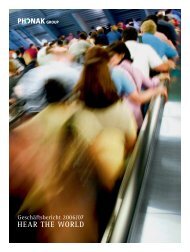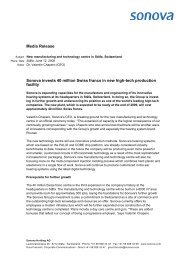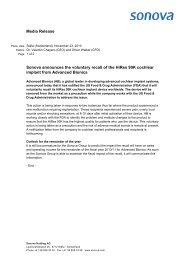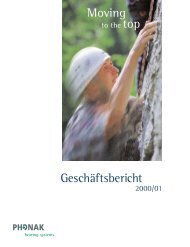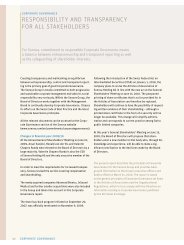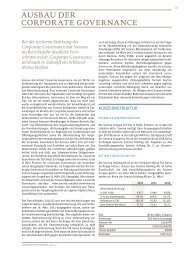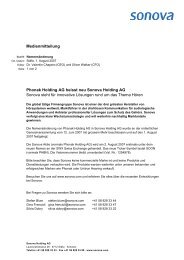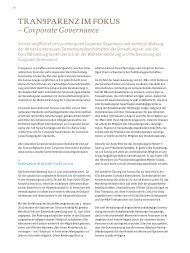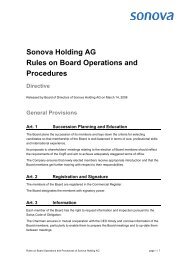Annual Report 2010/11 - Sonova
Annual Report 2010/11 - Sonova
Annual Report 2010/11 - Sonova
You also want an ePaper? Increase the reach of your titles
YUMPU automatically turns print PDFs into web optimized ePapers that Google loves.
THE HEARING INSTRUMENT MARKET –<br />
CONTINUOUS GROWTH<br />
According to estimates, more than 9.5 million hearing<br />
instruments were sold worldwide last year. Europe, the<br />
Middle East and Africa (EMEA) account for roughly 45%<br />
of the global market, while around 35% of products are<br />
sold in the USA and 20% in the rapidly developing Asia/<br />
Pacific region. <strong>Sonova</strong> is well established in the target<br />
markets of North America and Europe and is pursuing<br />
a clear growth strategy in the emerging markets.<br />
SALES BY SEGMENTS <strong>2010</strong>/<strong>11</strong><br />
in %<br />
Hearing instruments<br />
Hearing implants<br />
The market for hearing instruments has been growing continuously<br />
for years – a trend that is expected to continue.<br />
Unit sales in the hearing instrument segment grew by an<br />
estimated 4–5% last year. <strong>Sonova</strong> estimates the long-term<br />
average growth in unit sales worldwide to be 4–7% per year.<br />
HEARING INSTRUMENTS PENETRATION RATE<br />
Penetration rate in %:<br />
100<br />
75<br />
50<br />
25<br />
4<br />
96<br />
HEARING INSTRUMENTS<br />
One key growth driver is demographic development: as<br />
a result of population growth, longer life expectancy, an<br />
increase in average age, and exposure to noise pollution at<br />
work and in leisure time, an increasing number of people<br />
need a hearing instrument. In addition, an above-average<br />
increase in demand for hearing instruments is expected<br />
among the baby boomer generation in the coming years.<br />
The number of replacement purchases increases the older<br />
a person becomes, while more and more young people are<br />
being diagnosed with hearing loss. In the future, people<br />
will wear hearing instruments over a much longer period of<br />
their lives and will require a larger number of systems.<br />
Further potential lies in the relatively low penetration rate:<br />
only 20% of people in the industrialized countries who<br />
would benefit from a hearing instrument currently wear one.<br />
Penetration generally depends to a large extent on the<br />
degree of hearing loss: 70% of people with severe to profound<br />
hearing loss who can barely manage in everyday<br />
life without the assistance of technology wear a hearing<br />
system. The penetration rate is just under 50% for people<br />
with moderate hearing loss and only 10% for people with<br />
mild hearing loss.<br />
Emerging markets, including South America and Asia Pacific,<br />
increasingly become a growth driver as well. With the<br />
average income steadily rising in these regions, a continuously<br />
growing penetration rate can be expected in these<br />
markets in the coming years.<br />
0<br />
10%<br />
Hearing loss degree: mild moderate<br />
severe<br />
to profound<br />
Penetration rate of people in the industrial countries<br />
50%<br />
70%<br />
17



